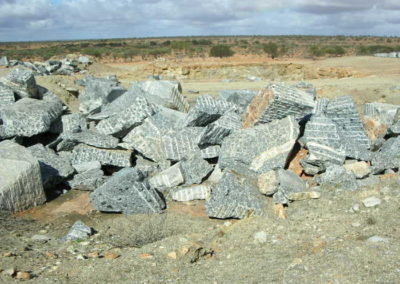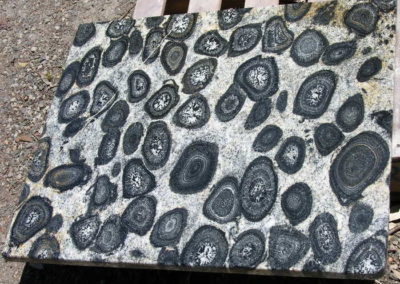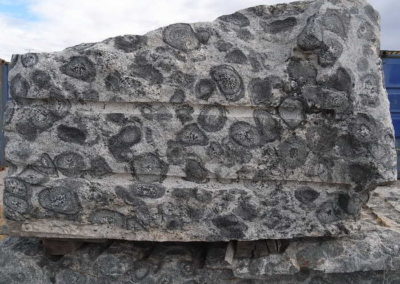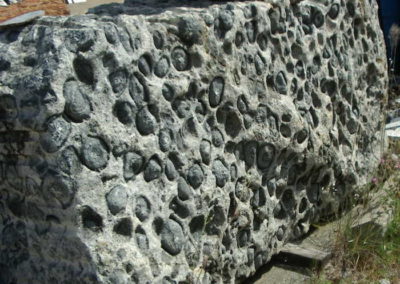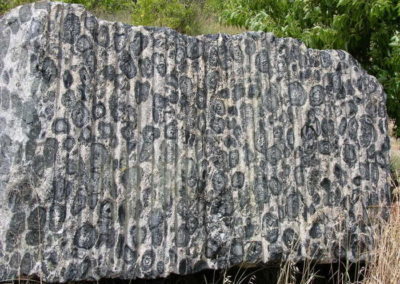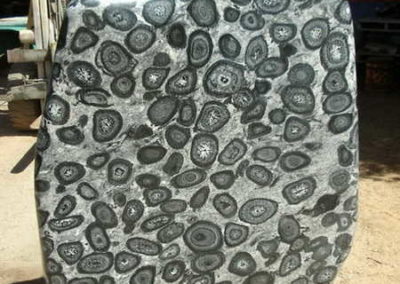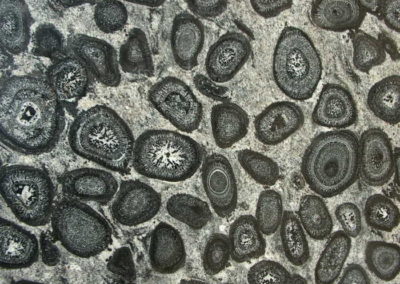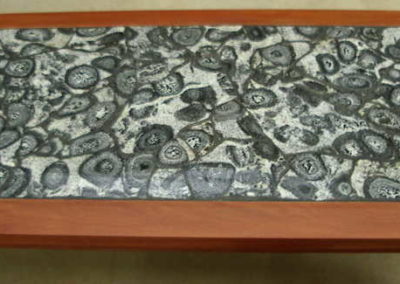The dark, layered balls are made up largely of crystals of blackish hornblende (an iron-bearing silicate mineral) and creamy white feldspar (a sodium-calcium aluminium silicate), with smaller amounts of other minerals. Because of this mineral composition, it is not a true granite, and is more properly termed a “granitoid”.
This particular example of orbicular rock is over two and a half billion years old. It is an igneous rock which has crystallised from molten material pooled in the Earth’s crust. Normally as the melt cools, many crystals would start to form, but here the sites for crystallisation were few, and radiating/concentric crystal frameworks developed, with the different layers reflecting the conditions at the time of formation. The orbs were formed in parts of the magma chamber which were ideal for rapid crystal growth, and it is envisaged that the developing spheres were swept up and down by currents in the molten rock, just like hailstones are in a storm cloud, each journey adding a new layer of crystals. Eventually the entire rock solidified. In this deposit the original rock has been overprinted by later events, particularly the replacement by other minerals of much of the matrix surrounding the orbs.
ARCHAEAN ORBICULAR GRANITOIDS FROM BOOGARDIE, NEAR MT MAGNET, WESTERN AUSTRALIA
Jenny Bevan
School of Earth and Geographical Sciences, University of Western Australia, Australia Orbicular textures, i.e., concentrically-zoned spheroidal structures, occur in a wide range of rocks, and can vary in their genesis. Some of the more spectacular are found in igneous rocks with the compositional range from diorite to granite. The first example described here typically has orbicules of dioritic composition in a matrix of a titanite-rich granite; the second is overall largely granitic in nature. In the main deposit, the material comprises orbicular structures of radiating and granular concentric shells, largely of hornblende and plagioclase, around cores of varying kinds, in a granular matrix. Smaller, more ‘primitive’ orbicules contain relict pyroxene within amphibole, and few layers of simple composition; larger, complex ones have extensive biotite development and iron and titanium oxides in their outer layers. The matrix is coarse, granular and granitic in nature, and may contain large (centimetre-sized) euhedral titanite. Later, non-dilatational pegmatites cut orbicules and matrix, and areas of the orbicular outcrop show replacement by a distinctive porphyritic granite. It is proposed that the orbicules formed essentially by crystallisation from a magma. Variations in the type and structure of orbicules can be explained by a multi-stage process of formation. The initial orbicules crystallised from a fluid-rich supercooled dioritic magma, in which nucleation centres were sparse. Some orbs nucleated on seed crystals but others have nucleated on amphibolitic xenoliths or, later, on fragments of previously-formed orbicules. The presence of broken fragments confirms that the orbicules were mobile within a melt, and the mineralogy of the ‘comb-layered’ shells suggests extensive movement within the magma chamber, by convection currents within fluid-rich margins, as proposed by previous authors. Orbicules appear to have settled under gravity into a discrete deposit, perhaps while each was still a skeletal mesh of crystals, since orbicules are frequently deformed or moulded one against another. Some orbicules appear to have been entrained by flow, and elsewhere there is evidence that orbicules have been moved en masse after settling. Accumulation of orbicules depleted the magma in mafic elements and increased the silica and fluid content, and the granitic nature of the matrix and of the later partial replacements of cores and shells of some orbs indicate a gradation into fluid-driven, subsolidus processes. Biotite flakes cut primary crystals and are thought to be secondary; titanite also shows characteristic replacement textures. A second occurrence of markedly-different orbicular rocks in the same area contains orbicules with pale, thick shells of granular and radiating plagioclase, quartz and biotite around large, non-radiating granitic cores. The granitic matrix of these orbicules is also dissimilar to the matrix of those in the larger deposit, and there are no pegmatite dykes. The age of the major deposit has been determined by SHRIMP U-Pb analysis of coarse matrix titanite to be 2687 ± 5 Ma, making the Boogardie orbicular granitoids among the oldest known. Selected photographs can be viewed on <www.geol.uwa.edu.au/~jbevan/>.

